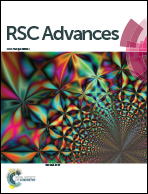Maskless, site-selective, nanoaerosol deposition via electro-aerodynamic jet to enhance the performance of flexible Ag-grid transparent electrodes†
Abstract
Grid-type transparent electrodes (TEs) have been fabricated using various techniques, but enhancing the performance of TEs remains challenging. In this study, we developed an aerosol deposition methodology whereby airborne silver nanoparticles of 32 nm diameter were electrically charged and delivered through a nozzle to a pre-patterned silver grid with periodic silver lines (width 18 μm, thickness 360 nm, and pitch 500 μm). A high voltage of 7 kV was applied between the nozzle and the grid, located 10 mm away from the nozzle, such that charged silver nanoparticles were deposited on the grid without the requirement for masking. The pre-patterned silver grid was prepared with AC pulse applied electrohydrodynamic jet printing on a PET film. After 3 minutes of deposition, the grid thickness increased from 360 nm to 587 nm, resulting in decreased TE sheet resistance from 7.38 Ω sq−1 to 1.95 Ω sq−1 while transmittance was kept constant at 84% (σDC/σOP ratio increased from 300 to 1050).


 Please wait while we load your content...
Please wait while we load your content...